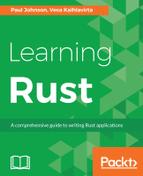The final form of loop to consider is known as a recursive function. This is a function that calls itself until a condition is met. In pseudocode, the function looks like this:
float my_function(i32:a: i32)
{
// do something with a
if (a != 32)
{
my_function(a);
}
else
{
return a;
}
}
An actual implementation of a recursive function would look like this:
// 04/recurse-1/src/main.rs
fn recurse(n: i32) { let v = match n % 2 { 0 => n / 2, _ => 3 * n + 1 }; println!("{}", v); if v != 1 { recurse(v) } } fn main() { recurse(25) }
The idea of a recursive function is very simple, but we need to consider two parts of this code. The first is the let line in the recurse function and what it means:
let v = match n % 2
{
0 => n / 2,
_ => 3 * n + 1
};
Another way of writing this is as follows:
let mut v = 0i32;
if n % 2 == 0
{
v = n / 2;
}
else
{
v = 3 * n + 1;
}
The second part is that the semicolon is not being used everywhere. Consider the following example:
fn main()
{
recurse(25)
}
